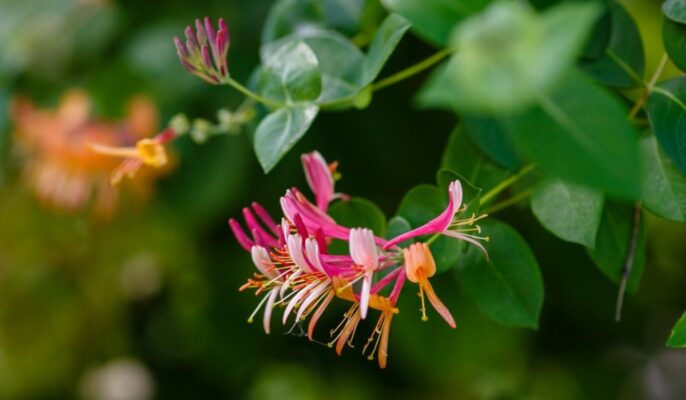Honeysuckle is more than just a fragrant flower- it’s a versatile plant with different types that can enhance gardens. These vines ranging from invasive to garden-friendly types, wind their way through yards, beautifying any spaces. Whether climbing on trellises, covering fences or spreading on the ground, this enchanting plant brings joy to nature lovers and has some medicinal uses too. Check this guide for a comprehensive overview, key facts, characteristics, tips for growing and care about Honeysuckle.
Honeysuckle: Key facts
| Common name | Common Honeysuckle, European Honeysuckle, Woodbine |
| Botanical name | Lonicera periclymenum |
| Family | Caprifoliaceae |
| Plant type | Perennial, Shrub, Groundcover, Vine, Deciduous, Evergreen and Semi Evergreen |
| Mature size | 12-20 ft tall, 3-6 ft wide |
| Light exposure | Partially shade to full |
| Soil Type | Moist, well-drained, rich |
| Soil pH | Neutral (5.5 to 8.0) |
| Bloom Time | Late Winter/Early spring, Summer |
| Flower Color | Pink, orange, yellow, white |
| Hardiness Zones | Zones 5-9 (USDA) |
| Native Area | Europe, Asia, Africa |
Honeysuckle: Characteristics
Honeysuckle (Lonicera periclymenum) boasts over 180 varieties, each known for its aromatic tubular flowers and attractiveness to pollinators. Whether climbing vines or arching shrubs, these plants exhibit dark green to blue-green leaves. The deciduous or evergreen nature of Honeysuckle and trumpet-shaped flowers in clusters add to their charm. It’s a fast-growing, low-maintenance plant that thrives in full sunlight with well-drained, moist soil.
Honeysuckle: Types
- Trumpet honeysuckle (Lonicera sempervirens): Also known as coral Honeysuckle, it is native to North America and loved by ruby-throated hummingbirds.
- Japanese Honeysuckle (Lonicera japonica): Invasive vine with red or pink blossoms, suitable for trellises or ground cover.
- Winter honeysuckle (Lonicera fragrantissima): Blooms in late winter with white flowers and a lemony scent.
- Sakhalin honeysuckle (Lonicera maximowiczii var. sachalinensis): Shrub with red flowers and adaptable nature.
- Blue Honeysuckle (Lonicera caerulea): Known for edible blueberries and fragrant white flowers.
Honeysuckle: How to grow?
Planting Honeysuckle in early spring, using supports for climbing varieties and proper watering after flowering contribute to a thriving honeysuckle garden. Choose the right location—a sunny, moist spot with well-drained soil.
Propagation techniques
- Where to plant: Choose a sunny, moist spot for optimal growth.
- Support structures: Install supports based on whether they are ground cover or climbing.
- Planting time: Optimal planting time is post-frost in early spring.
- Planting process: Dig a hole, mix soil with compost, transplant, water, and secure climbing varieties.
- Care tips: Cover the base with compost, water regularly, and prune after flowering.
Planting in containers
- Container size: Select a large container, 2-3 times the root ball size.
- Planting process: Fill with soil, transplant, add support, and train the Honeysuckle.
- Climbing support: Provide a trellis or stakes for vertical growth.
Propagating from cuttings
- Take cuttings: Choose six to eight-inch pieces from a mature honeysuckle.
- Outer layer removal: Optional scraping of the stem’s outer layer.
- Root hormone treatment: Dip in root hormone for enhanced root growth.
- Plant and cover: Plant in fresh soil, cover with a plastic bag for humidity, and wait for root development.
Sowing honeysuckle seeds
- Seed collection: Harvest dry, ripe seeds from spent flowers.
- Drying process: Dry seeds in a well-ventilated room for 2-6 weeks.
- Planting seeds: Plant in moist perlite soil, water immediately, and observe germination.
Honeysuckle: Care tips
Caring for Honeysuckle involves light, soil, water, temperature, and fertilisation considerations.
- Light: Honeysuckle thrives in at least six hours of daily sunlight, with partial shade tolerated.
- Soil: Well-drained, moist, and organically rich soil with a neutral pH is ideal.
- Water: Consistent watering, especially for newly planted Honeysuckle, is crucial. Mulching helps retain moisture.
- Temperature and humidity: Honeysuckle is heat-tolerant but dislikes excessive humidity.
- Fertiliser: Use balanced fertiliser in spring and consider nitrogen supplements for increased growth.
Honeysuckle: Benefits and uses
Honeysuckle transcends its ornamental value, finding applications in traditional medicine:
- Anti-microbial properties: Combat bacteria associated with various infections.
- Health benefits: Address inflammation, digestive disorders, and skin ailments.
- Laxative and diuretic: Promote detoxification and lower fever during sickness.
- Culinary uses: Create syrups, tinctures, or glycerites for unique recipe flavours.
Honeysuckle: Pests and diseases
Aphids and powdery mildew are common issues. Adequate watering, proper spacing, and mulching can prevent these problems. Regularly check for signs of diseases and pests and prune damaged foliage.
- Aphids: Control with insecticidal soaps or encourage natural predators.
- Powdery mildew: Plant in partial shade, maintain good airflow, and avoid over-congestion.
Honeysuckle: Toxicity
While Honeysuckle is generally of low toxicity, ingestion can lead to gastrointestinal upset with symptoms like vomiting, diarrhoea and lethargy. Most animals recover well, with proper treatment if needed.
FAQs
Where should I plant the Honeysuckle to avoid pests and diseases?
Plant in partial sun or dappled shade to prevent aphids and powdery mildew.
Does Honeysuckle grow in the shade?
While it needs some light, Honeysuckle prefers roots in shade and foliage in sunlight.
How fast does Honeysuckle grow?
Fast-growing, flowering in the first year and reaching maturity in 2-5 years.
Can I grow Honeysuckle indoors?
Select a suitable indoor variety and provide adequate sunlight.
Does Honeysuckle grow in pots?
Yes, using quality composite and support structures in large containers with good drainage.
Is Honeysuckle safe for pets?
Generally safe, but if ingested gastrointestinal upset, lack of appetite, drooling and diarrhoea may result in pets.
What is the utility of Honeysuckle?
Honeysuckle contains essential oils and antioxidants like quercetin, and its flowers, seeds, berries, and leaves are used medicinally. Honeysuckle may also have antiviral and anti-inflammation properties.
| Got any questions or point of view on our article? We would love to hear from you. Write to our Editor-in-Chief Jhumur Ghosh at jhumur.ghosh1@housing.com |
